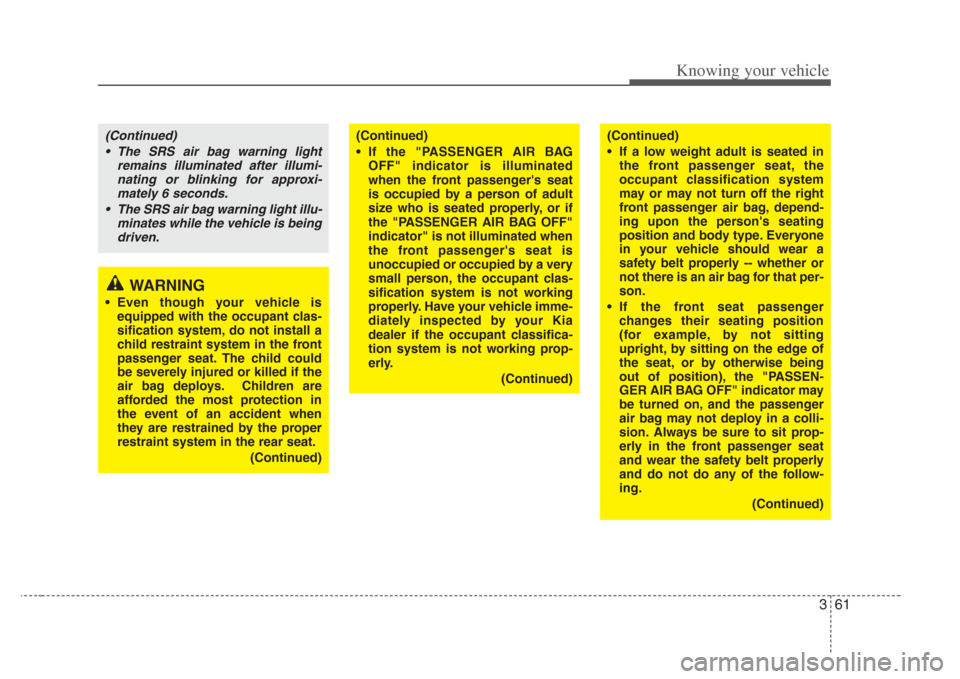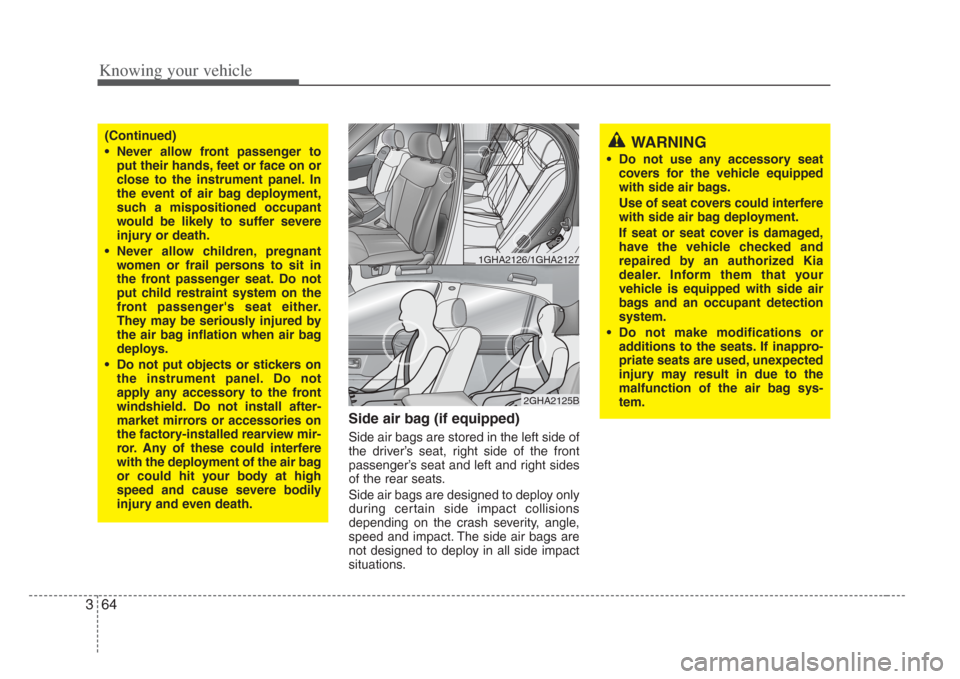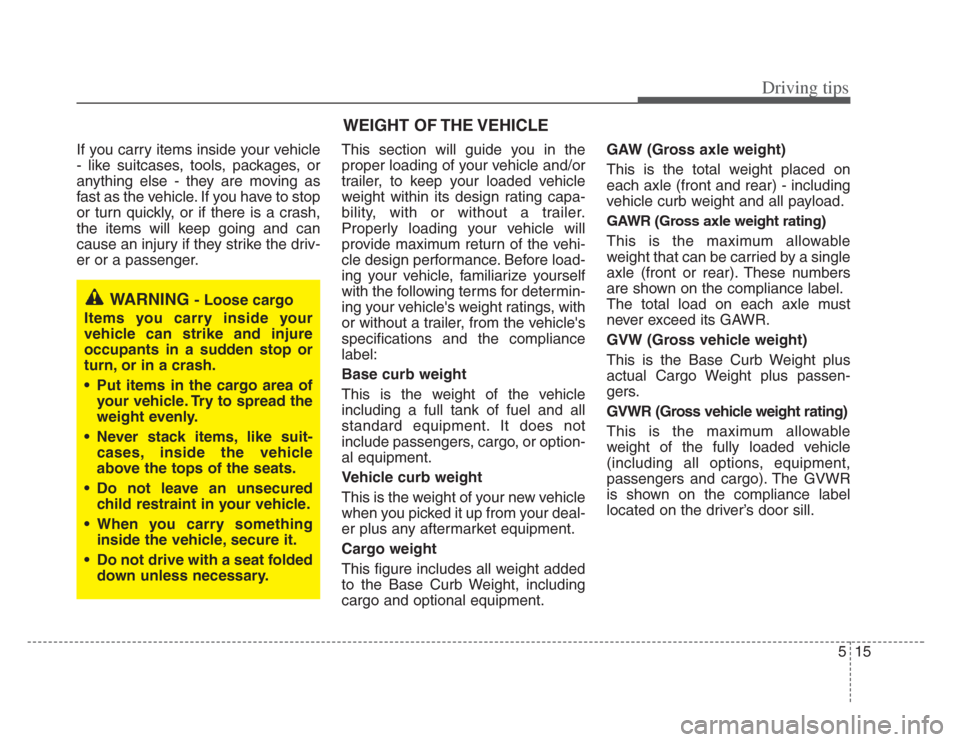2008 KIA Opirus child seat
[x] Cancel search: child seatPage 70 of 283

Knowing your vehicle
603
Condition and operation in the front passenger occupant
cla ssification system
Condition detected by
the occupant classifi- cation system
1. Adult *
1
2. Child*2or child
restraint system
3. Unoccupied Off
On
OnOff
Off
Off
Activated
Deactivated
Deactivated
"PASSENGER AIR
BAG OFF" indicator lightAIR BAG
warning light Front passenger
front air bag
Indicator/Warning light
Device
*1The system detects a person who is generally adult size as an adult, thus allowing the pas-
senger air bag to deploy. When a smaller adult sits in the front passenger seat, the system
may detect their body shape as that of a child, thus preventing air bag deployment.
*
2When a larger child who has outgrown a child restraint system sits in the front passenger seat, the system may recognize him/her as an adult depending on his/her body shape or seating
position, thus permitting air bag deployment.
CAUTION
If the "PASSENGER AIR BAG OFF" indicator illuminate s or blinks continu-
ously when a per son of adult size sits in the front passenger's seat, it could
be because that per son isn't sitting properly in the seat. If this happens, turn
the vehicle off, make sure the seat back is not reclined, have the passenger center on the seat cushion, with legs comfortably extended, and the safety
belt properly po sitioned. Restart the vehicle and have the per son remain in
this position long enough to allow the system to detect the person and acti-
vate the passenger air bag.
CAUTION
If the occupant cla ssification sys-
tem is not working properly, the air bag warning light ( ) on theins trument panel will illuminate
because the passenger’ s air bag is
connected with the occupant cla s-
sification system. If there is a mal-
function of the occupant cla ssifica-
tion system, the "Passenger Air bag
Off" indicator will not illuminate and the front passenger's air bag will deploy in frontal crashes even ifthere is child or no occupant in the front passenger's seat.
Have an authorized Kia dealer inspect the occupant cla ssification
system with the SRS air bag system as soon as possible if any of follow-
ing occur;
• The SRS air bag warning light does not illuminate when the igni-tion key i s turned to "ON" po si-
tion.
(Continued)
AIR
BAG
Page 71 of 283

361
Knowing your vehicle
WARNING
• Even though your vehicle isequipped with the occupant cla s-
sification system, do not install a
child restraint system in the front
passenger seat. The child could
be severely injured or killed if the
air bag deploys. Children are
afforded the mo st protection in
the event of an accident when
they are restrained by the proper
restraint system in the rear seat.
(Continued)
(Continued)
• If the "PASSENGER AIR BAGOFF" indicator is illuminated
when the front pa ssenger's seat
is occupied by a per son of adult
size who is seated properly, or if
the "PASSENGER AIR BAG OFF"
indicator" is not illuminated when
the front passenger's seat is
unoccupied or occupied by a very
small per son, the occupant cla s-
sification system is not working
properly. Have your vehicle imme-
diately ins pected by your Kia
dealer if the occupant cla ssifica-
tion system is not working prop-
erly.
(Continued)(Continued)
• If a low weight adult is seated in
the front passenger seat, the
occupant classification system
may or may not turn off the right
front passenger air bag, depend-
ing upon the per son's seating
position and body type. Everyone
in your vehicle should wear a
safety belt properly -- whether or
not there i s an air bag for that per-
son.
• If the front s eat passenger
changes their s eating pos ition
(for example, by not s itting
upright, by sitting on the edge of
the seat, or by otherwi se being
out of position), the "PASSEN-
GER AIR BAG OFF" indicator may
be turned on, and the pa ssenger
air bag may not deploy in a colli-
sion. Always be sure to sit prop-
erly in the front pa ssenger seat
and wear the safety belt properly
and do not do any of the follow-
ing.
(Continued)(Continued)• The SRS air bag warning light remains illuminated after illumi-nating or blinking for approxi-mately 6 seconds.
• The SRS air bag warning light illu- minates while the vehicle is beingdriven.
Page 74 of 283

Knowing your vehicle
643
Side air bag (if equipped)
Side air bags are stored in the left side of
the driver’s seat, right side of the front
passenger’s seat and left and right sides
of the rear seats.
Side air bags are designed to deploy only
during certain side impact collisions
depending on the crash severity, angle,
speed and impact. The side air bags are
not designed to deploy in all side impact
situations.
WARNING
• Do not use any accessory seat
cover s for the vehicle equipped
with side air bags.
Use of seat cover s could interfere
with side air bag deployment.
If seat or seat cover is damaged,
have the vehicle checked and
repaired by an authorized Kia
dealer. Inform them that your
vehicle is equipped with side air
bags and an occupant detection
system.
• Do not make modifications or
additions to the seats. If inappro-
priate seats are u sed, unexpected
injury may result in due to the
malfunction of the air bag sys-
tem.
2GHA2125B
1GHA2126/1GHA2127
(Continued)
• Never allow front passenger to put their hand s, feet or face on or
clo se to the instrument panel. In
the event of air bag deployment,
such a mispositioned occupant
would be likely to suffer severe
injury or death.
• Never allow children, pregnant women or frail per sons to sit in
the front passenger seat. Do not
put child restraint system on the
front passenger's seat either.
They may be seriously injured by
the air bag inflation when air bag
deploys.
• Do not put object s or stickers on
the ins trument panel. Do not
apply any accessory to the front
windshield. Do not install after-
market mirror s or accessories on
the factory-installed rearview mir-
ror. Any of these could interfere
with the deployment of the air bag
or could hit your body at high
speed and cause severe bodily
injury and even death.
Page 75 of 283

365
Knowing your vehicle
Curtain air bag
Curtain air bags are located along both
sides of the roof rails above the front and
rear doors.
It is designed to help protect the heads of
the front seat occupants and the rear out-
board seat occupants in certain side
impact collisions.• The curtain air bag deployment occurs
only on the side of the vehicle affected
by the impact.
• The side air bags (side and curtain air bags) are not designed to deploy dur-
ing collisions from the front or rear of
the vehicle or in most rollover situa-
tions.
• The curtain air bags are designed to deploy only during certain side-impact
collisions, depending on the crash
severity, angle, speed and impact. The
curtain air bags are not designed to
deploy in all side impact situations.
WARNING
• In order for side air bags ( side
and curtain air bag s) to provide
best protection, both front seat
occupants and both outboard
rear occupants should sit in an
upright pos ition with the s eat
belts properly fas tened.
Importantly, children should sit in
a proper child restraint system in
the rear seat.
(Continued)
(Continued)
• When children are seated in the
rear outboard seats, they must be
s eated in the proper child
restraint system. Make sure to put
the child restraint system as far
away from the door side as possi-
ble, and securely lock the child
restraint system in position.
• Do not allow the pa ssengers to
lean their head s or bodies onto
door s, put their arms on the
door s,stretch their arms out of
the window, or place objects
between the door s and passen-
ger s when they are seated on
s eats equipped with s ide air
bags.
• Never try to open or repair any components of the side curtain
air bag system.
This should only
be done by an authorized Kia
dealer.
Failure to follow the above men-
tioned ins tructions can res ult in
injury or death to the vehicle occu-
pants in an accident.
2GHA2125
2GHA2125A
Page 83 of 283

373
Knowing your vehicle
Installing a child restraint on a
front passenger’ s seat is forbid-
den.
Never place a rear-facing child restraint
in the front passenger’s seat. If the air
bag deploys, it would impact the rear-fac-
ing child restraint, causing serious or
fatal injury.
In addition, do not place front-facing
child restraint in the front passenger’s
seat either. If the front passenger air bag
inflates, it would cause ser ious or fatal
injuries to the improperly positioned or
improperly restrained child.
Air bag warning light
The purpose of the air bag warning light in
your instrument panel is to alert you of a
potential problem with your air bag -
Supplemental Restraint System (SRS).
When the ignition switch is turned ON,
the indicator light should blink or illumi-
nate for approximately 6 seconds, then
go off.
Have the system checked if:
• The light does not turn on briefly when you turn the ignition ON.
• The light stays on after the engine starts.
• The light comes on while the vehicle is in motion.
ADAIRBAG
AIR
BAG
WARNING
• Never put child restraint in the front passenger’ s seat. If the front
passenger air bag inflates ,it
would caus e serious or fatal
injuries.
• When children are seated in the rear outboard seats in which side
air bags are equipped, be sure to
put the child restraint system as
far away from the door side as
possible, and securely lock the
child restraint system in position.
Inflation of side or curtain air bag
could caus e serious injury or
death due to the expans ion
impact.
Page 138 of 283

47
Driving your vehicle
R (reverse)
Use this position to drive the vehicle
backward.
✽
NOTICE
Always come to a complete stop before
shifting into or out of R (Reverse); you
may damage the transaxle if you shift
into R while the vehicle is in motion,
except as explained in “Rocking the
Vehicle”, in this manual.
N (neutral)
With the gearshift in the N position, the
wheels and transaxle are not locked. The
vehicle will roll freely even on the slight-
est incline unless the parking brake or
service brakes are applied.
D (drive)
This is the normal forward driving posi-
tion. The transaxle will automatically shift
through a 5-gear sequence, providing the
best fuel economy and power.
For extra power when passing another
vehicle or climbing grades, depress the
accelerator fully, at which time the
transaxle will automatically downshift to
the next lower gear.(Continued)
• Before leaving the driver’ s seat,
always make sure the shift lever
is in the P (PARK) position. Set
the parking brake fully, shut the
engine off and take the key with
you. Unexpected and s udden
vehicle movement can occur if
you do not follow these precau-
tions in the order specified.
• Never leave a child unattended in a vehicle.
CAUTION
The transaxle may be damaged ifyou shift into P (Park) while the
vehicle is in motion.
Page 199 of 283

515
Driving tips
If you carry items inside your vehicle
- like suitcases, tools, packages, or
anything else - they are moving as
fast as the vehicle. If you have to stop
or turn quickly, or if there is a crash,
the items will keep going and can
cause an injury if they strike the driv-
er or a passenger.This section will guide you in the
proper loading of your vehicle and/or
trailer, to keep your loaded vehicle
weight within its design rating capa-
bility, with or without a trailer.
Properly loading your vehicle will
provide maximum return of the vehi-
cle design performance. Before load-
ing your vehicle, familiarize yourself
with the following terms for determin-
ing your vehicle's weight ratings, with
or without a trailer, from the vehicle's
specifications and the compliance
label:
Base curb weight
This is the weight of the vehicle
including a full tank of fuel and all
standard equipment. It does not
include passengers, cargo, or option-
al equipment.
Vehicle curb weight
This is the weight of your new vehicle
when you picked it up from your deal-
er plus any aftermarket equipment.
Cargo weight
This figure includes all weight added
to the Base Curb Weight, including
cargo and optional equipment.GAW (Gross axle weight)
This is the total weight placed on
each axle (front and rear) - including
vehicle curb weight and all payload.
GAWR (Gross axle weight rating)
This is the maximum allowable
weight that can be carried by a single
axle (front or rear). These numbers
are shown on the compliance label.
The total load on each axle must
never exceed its GAWR.
GVW (Gross vehicle weight)
This is the Base Curb Weight plus
actual Cargo Weight plus passen-
gers.
GVWR (Gross vehicle weight rating)
This is the maximum allowable
weight of the fully loaded vehicle
(including all options, equipment,
passengers and cargo). The GVWR
is shown on the compliance label
located on the driver’s door sill.
WARNING - Loose cargo
Items you carry ins ide your
vehicle can s trike and injure
occupants in a sudden stop or
turn, or in a crash.
• Put items in the cargo area of your vehicle. Try to spread the
weight evenly.
• Never stack items, like suit-
cas es,in side the vehicle
above the top s of the seats.
• Do not leave an uns ecured
child restraint in your vehicle.
• When you carry s omething
inside the vehicle, secure it.
• Do not drive with a seat folded
down unless necessary.
WEIGHT OF THE VEHICLE